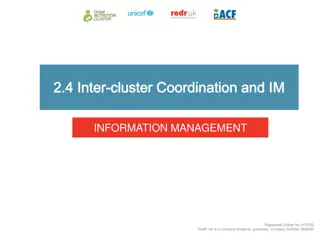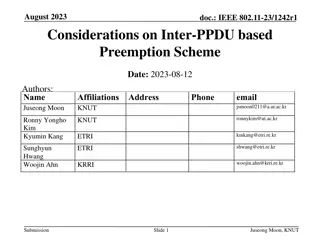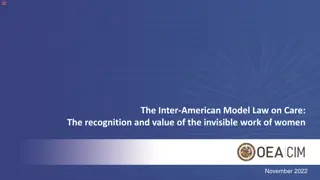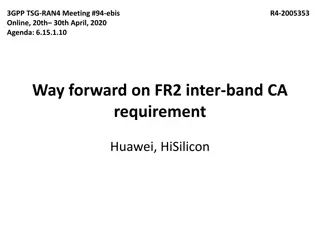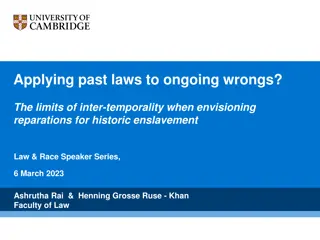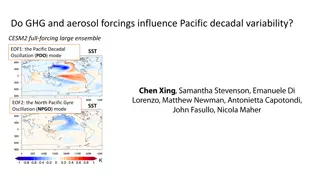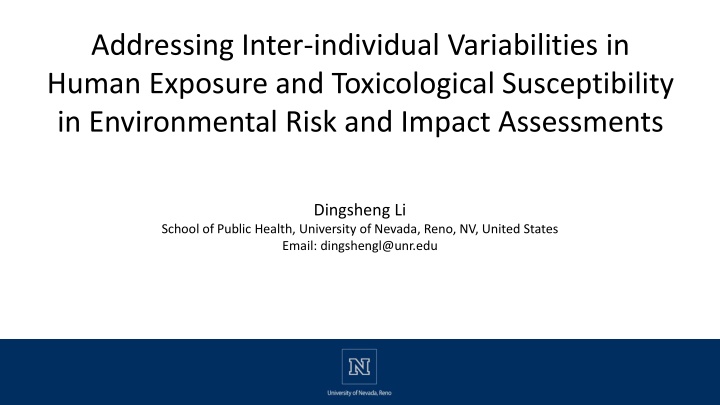
Addressing Inter-individual Variabilities in
Linear health risk/impact assessments are widely used, assuming linearity and homogeneity in human responses to toxicants. However, non-linearity is common, reflecting differences in dietary patterns, behavior, genetics, and development stages. A study aims to simulate US population exposures to lipophilic chemicals and explore different dose-response relationships to understand health impacts.
Download Presentation

Please find below an Image/Link to download the presentation.
The content on the website is provided AS IS for your information and personal use only. It may not be sold, licensed, or shared on other websites without obtaining consent from the author. If you encounter any issues during the download, it is possible that the publisher has removed the file from their server.
You are allowed to download the files provided on this website for personal or commercial use, subject to the condition that they are used lawfully. All files are the property of their respective owners.
The content on the website is provided AS IS for your information and personal use only. It may not be sold, licensed, or shared on other websites without obtaining consent from the author.
E N D
Presentation Transcript
Addressing Inter-individual Variabilities in Human Exposure and Toxicological Susceptibility in Environmental Risk and Impact Assessments Dingsheng Li School of Public Health, University of Nevada, Reno, NV, United States Email: dingshengl@unr.edu
Linear health risk/impact assessment Widely adopted in subjects concerning human health, such as risk assessment and life cycle assessment Often taking the assumption of linearity and homogeneous: All individuals are represented by the average human and scaled linearly Same exposure, same susceptibility to the toxicant A linear dose-response relationship is also often adopted
Linear health risk/impact assessment Average person Response 7.8 billion ADD ADD
Non-linearity everywhere Just to name a few - Dietary pattern: variation among ethnic groups Behavior: significantly higher hand-to-mouth for toddlers Genetic differences: lactose intolerance Development stage: children generally more susceptible Dose-response relationship is unlikely to be linear as well
Objective of this study Simulate US population daily oral doses for two lipophilic persistent organic chemicals (dieldrin and heptachlor) based on the real age, sex, and race distribution and dietary patterns Use three dose-response relationship: linear, non-linear with homogeneous susceptibility, and non-linear with heterogeneous susceptibility Explore the overall health impact for these different exposure and dose- response relationships
Demographic exposure 8 8 Using the model PROTEX (Li et al., 2018a,b), daily oral dose (DOD, in g/kg/d) of dieldrin and heptachlor are predicted for archetypal, average males and females of four groups of race across 0 to 80 years of age Anthropometric and dietary data sourced from NHANES and US Agricultural Research Service Male Male Female Female Daily oral dose ( g/kg/d) Daily oral dose ( g/kg/d) 6 6 Asian 4 4 Hispanic Black White 2 2 0 0 0 20 40 60 80 0 20 40 60 80 Age Dieldrin for illustration Age
Demographic exposure Using the demographic composition from the US Census Bureau data, we generate a virtual population using Monte-Carlo simulation to represent the US population but with 0.1% of its size Individual specific estimates can be further examined for heterogeneous exposure Median of this population can be extrapolated linearly for homogeneous exposure Frequency of daily oral dose Median 0 1 2 3 4 5 6 7 8 Daily oral dose ( g/kg/d) Dieldrin for illustration
Dose-response relationship Health impact is quantified using the probability of occurrence of adverse health effect (PrHE), assuming the level of exposure persists over the lifetime Extrapolated from the effective dose 50% (ED50) with a linear and non-linear relationship ED50 for dieldrin: 55 g/kg/d (Rosenbaum et al., 2011) ED50 for heptachlor: 2,860 g/kg/d (Rosenbaum et al., 2011)
Dose-response relationship Linear relationship (Rosenbaum et al., 2011): PrHElinear,ind= ???ind 50% ??50 The probability of occurrence of adverse health effect is simply multiplication of the individual s daily oral dose and the slope of the linear dose-response relationship
Dose-response relationship Non-linear relationship (Huijbregts et al., 2005) 2 log???ind ??50 ?ind 1 ???ind 2 ? PrHEnonlinear,ind= ?ind 2? ???ind ln10????ind 0 ind [unitless] is the spread in human susceptibility in a lognormal distribution With ind fixed at default value of 0.26, we have homogeneous susceptibility With ind sampled from a central tendency of 0.26 and a squared geometric standard deviation of 2.5, we have heterogeneous susceptibility
Health impact calculation Calculated probabilities of occurrence of health effects of virtual individuals aggregated (n=1, 2, , 329,131), then scaled to the total US population, yielding the total expected cases of disease (HI): ? ?? =329131338 ???? ?????? ? ?=1
Distribution of exposure and risk 1.E+00 0.05 0.08 1.E+00 Linear Probability of occurrence of health effect Probability of occurrence of health effect Linear Non-linear, 97.5th percentile 0.04 Frequency of daily oral dose Frequency of daily oral dose 1.E-02 Non-linear 97.5th percentile 0.06 1.E-12 Non-linear median 0.03 1.E-04 Non-linear, median 0.04 1.E-24 0.02 1.E-06 0.02 1.E-36 0.01 1.E-08 (a) Dieldrin (a) Dieldrin (b) Heptachlor (b) Heptachlor 0 0 1.E-10 1.E-48 0 1 2 3 4 5 6 7 8 9 10 0 1 2 3 4 5 6 Daily oral dose ( g/kg/d) Daily oral dose ( g/kg/d)
Distribution of exposure and risk Exposure Mid Susceptibility Low High Dieldrin Low Mid High Heptachlor Low Mid High 1.14 10-52 5.59 10-10 7.41 10-3 1.04 10-35 3.39 10-7 2.35 10-2 4.58 10-24 2.91 10-5 5.39 10-2 5.42 10-268 1.00 10-44 1.12 10-08 2.80 10-228 2.43 10-38 1.25 10-07 1.33 10-206 7.44 10-35 4.70 10-7 The probability of occurrence of health effects (unitless) calculated based on low, mid, and high levels of human exposure and toxicological susceptibility. The low, mid, and high levels of human exposure represent the 2.5th, 50th, and 97.5th percentiles of the daily oral doses of the modeled population, respectively. The low, mid, and high levels of toxicological susceptibility represent the 2.5th, 50th, and 97.5th percentiles of the toxicological susceptibility (slog), respectively.
Overall human health impacts Health impact (cases over lifetime) contribution (%)1 Top 10% individuals' Top 5% individuals' contribution (%)1 Top 1% individuals' contribution (%) Scenario Dieldrin Heptachlor Dieldrin Heptachlor Dieldrin Heptachlor Dieldrin Heptachlor (I) Heterogenous exposure and non- linear dose-response relationship with heterogeneous susceptibility (II) Heterogeneous exposure and non- linear dose-response relationship with homogeneous susceptibility 703,683 1,444 92.9% 100.0% 78.7% 100.0% 36.7% 99.7% 994 < 1 78.9% 99.8% 65.9% 99.6% 31.1% 94.2% (III) Heterogeneous exposure and linear dose-response relationship 8,624,257 72,748 15.7% 14.3% 8.7% 8.0% 2.3% 1.9% (IV) Homogeneous exposure and non- linear dose-response relationship with homogeneous susceptibility 112 < 1 25.0% 25.0% 25.0% 25.0% 25.0% 25.0% (V) Homogeneous exposure and linear dose-response relationship 8,409,856 73,082 25.0% 25.0% 25.0% 25.0% 25.0% 25.0% 1 Numbers rounded to one digit after decimal point. 100.0% is not exactly 100%
Observations Variation in exposure can be up to 6-fold, dominated by age difference body weight, food consumption rate Daily oral dose highest in early childhood Dietary patterns differ among races, but the difference is not material in the daily oral dose
Observations Linear At low exposure dose, linear dose-response relationship gives higher estimates of risks than its non-linear counterpart The difference gets smaller as exposure approaches the ED50, and can even be lower than the more susceptible population under the non- linear dose-response relationship 1 Probability of occurrence of health impact Non-linear, homogeneous susceptibility 1E-08 1E-16 Non-linear, heterogeneous susceptibility 1E-24 1E-32 1E-40 0 1 2 3 4 5 6 7 8 Daily oral dose ( g/kg/d)
Observations Compared to the estimate based on assumed heterogeneous exposure and heterogeneous susceptibility (more realistic scenario): Assuming a linear dose-response relationship overestimates the overall health impacts by more than an order of magnitude Assuming a non-linear dose-response relationship with homogeneous susceptibility underestimates the overall health impacts by over four orders of magnitude.
Observations The overall health impacts are contributed mainly by the small portion of highly susceptible, highly exposed individuals under the assumptions of heterogeneousexposure and non-linear dose- response relationship with heterogeneous susceptibility Compared to this perhaps more realistic scenario: Assuming a linear dose-response relationship overestimates the overall health impacts by more than an order of magnitude Assuming a non-linear dose-response relationship with homogeneous susceptibility underestimates the overall health impacts by over four orders of magnitude
Observations Results from homogeneous exposure and linear dose-response relationship may be too large: Using historical emission data, dieldrin would have caused an annual incidence rate of 37.4 per 100,000 in the United States This is close to the high end of estimates for health impacts from exposure to a wide range of endocrine-disrupting chemicals (Attina et al., 2016) Even rivals the annual incidence rate of syphilis (US CDC, 2019)
Limitations Emission was assumed to be constant The PROTEX model assumes homogeneous contamination in various environmental compartments and food items Toxicological susceptibility may follow different probability distribution among demographic groups The non-linear dose-response relationship is theoretical in nature
References Full paper: Li and Li, 2021. Frontiers in Sustainability, 2, 648138 Li et al., 2018a. Environ. Sci. Technol. 52, 6974-6984 doi: 10.1021/acs.est.8b00151 Li et al., 2018b. Environ. Int. 117, 57-68 doi: 10.1016/j.envint.2018.04.038 Rosenbaum et al., 2011. Int. J. Life Cycle Assess. 16, 710-727 doi: 10.1007/s11367-011-0316-4 Huijbregts et al., 2005. Integr. Environ. Assess. Manag. 1, 181-244 doi: 10.1897/2004-007R.1 Attina et al., 2016. Lancet Diabetes Endocrinol. 4, 996-1003 doi: 10.1016/S2213-8587(16)30275-3



